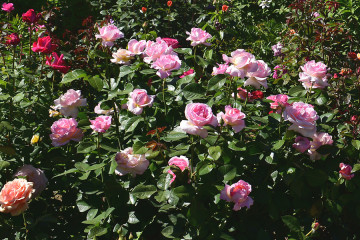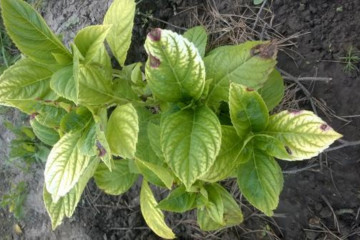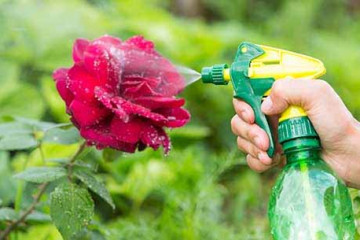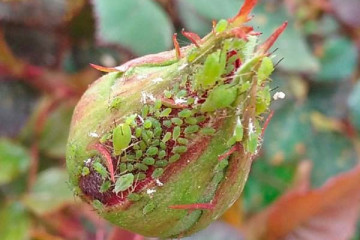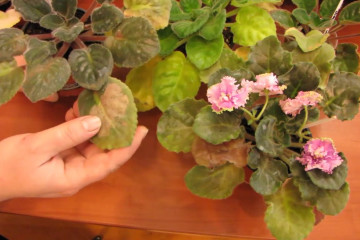White bloom on roses - what is it and how to treat
Content:
Roses during flowering are able to decorate any garden area. The appearance of a white bloom on foliage or in the area of buds can spoil the appearance of the plant. Below you can find out about the causes of a fungal infection and how to deal with an unpleasant ailment.
White bloom on roses - what is it
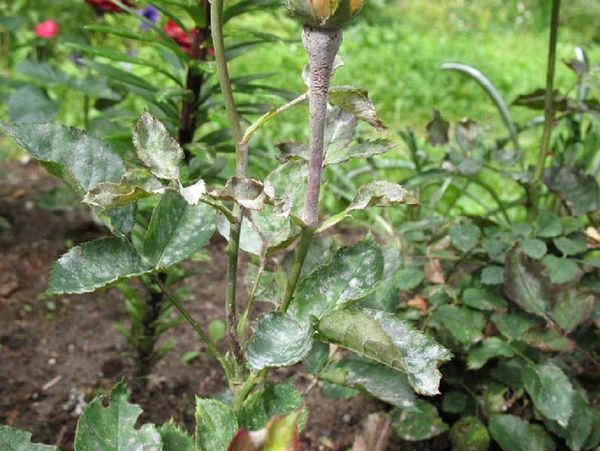
Having found a white bloom on the bushes, it is important to take care of the timely treatment of the rose.
The appearance of a white bloom on the bushes indicates the defeat of the rose with powdery mildew or other fungal infection. Why are roses growing in the garden affected by the fungus? The disease can develop against the background:
- waterlogging of the soil;
- overabundance of nitrogen fertilization in the soil;
- prolonged periods of drought;
- thickened planting.
The manifestation of gray rot is possible against the background of a low temperature regime and an increased level of humidity. White-gray spots, which will gradually begin to rot, will indicate an ailment. At the same time, the affected leaf plates fall off profusely.
When a rose is affected by powdery mildew, the foliage will turn white along with the buds and stems. Flowering stops, and the leaf plates curl. On the back of the leaves, spots appear that resemble mold in appearance.
Powdery mildew
Powdery mildew most often affects young shoots, leaf plates and buds. The causative agent of the disease is a parasitic fungus. The disease is characterized by a fairly rapid spread. Often, gardeners independently bring the disease into the garden, acquiring and planting diseased cuttings on the site. Powdery mildew can develop on plants against the background of:
- an overabundance of nitrogenous fertilizing;
- high humidity levels;
- dry soil around the root system;
- thickened planting of seedlings;
- high temperature conditions.
Signs of defeat
Affected plants suffer from the appearance of a whitish or grayish bloom, which may appear as spots on the lower and upper sides of the foliage. The shoots are strongly curved, flowering stops, and the bushes lose their attractive appearance.
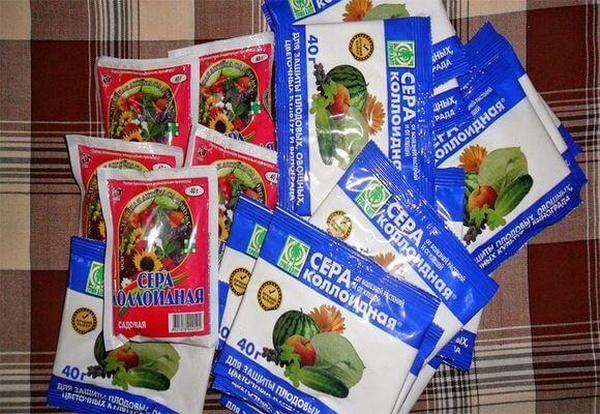
Colloidal Sulfur Treatment Can Help Deal With Powdery Mildew
How to deal with white bloom with powdery mildew
White bloom on the leaves of the rose indicates the defeat of the bushes with powdery mildew. It is important to process the ornamental culture as soon as possible using contact fungicidal agents.
Chemicals
Below you can find a description of the most effective chemicals that will help to cope with fungal diseases in a short period of time.
Colloidal sulfur
It is advisable to use colloidal sulfur at the initial stage of the disease, when the foliage of the rose is just beginning to turn white. Contact fungicide dissolves (30 g) in 10 liters of water. If the air temperature does not rise above 18 degrees, it is recommended to increase the concentration level of the solution.
"Tiovit Jet"
A ready-made contact-type agent, which contains a large percentage of sulfur, is best used at the initial stage of the disease. The solution is prepared by mixing 80 g of Tiovita Jeta with 10 liters of water. This fungicide greatly simplifies the fight against powdery mildew.
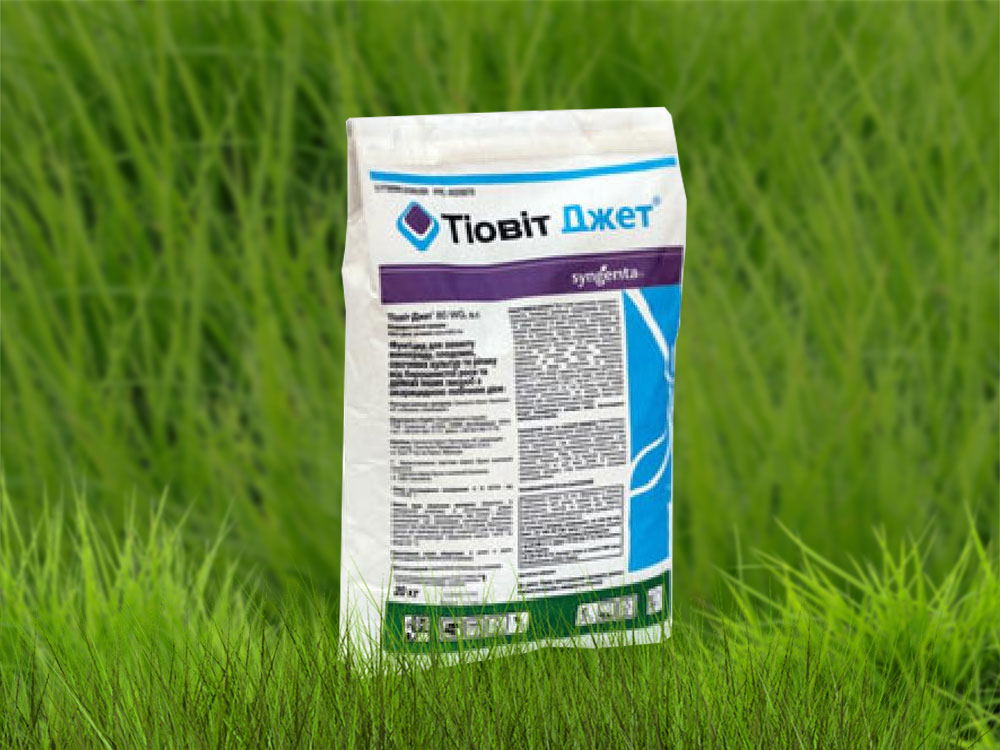
"Tiovit Jet" - a remedy that will help to cope with the disease at the initial stage
"Topaz"
A systemic fungicidal agent allows you to effectively fight fungal infections. "Topaz" can be used even for preventive purposes. In the process of preparing the working solution at home, you should adhere to the recommended concentration (for 5 liters of water, 2 ml of the drug is required). Processing is carried out twice with a break of 2 weeks.
"Speed"
If the question arose of how to treat mold on roses, you can use a universal systemic type agent that acts on the plant in a contact way. "Skor" is often used for prophylactic purposes, allowing to prevent diseases such as powdery mildew and gray rot. 10 liters of water will require 2 ml of the drug.
"Raek"
An analogue of "Skor" works for a long time. The bushes of garden roses, the branches of which have turned white and began to curl strongly, will be protected for a long time after processing. It is very important in the process of preparing the solution to strictly observe the dosage indicated on the package.
"Topsin M"
This tool allows you to quickly cure rose bushes from fungal infections. Fungicide can be used not only for treatment, but also for prophylactic purposes for indoor flowers. For every 10 liters of water, about 14-15 g of powder is required.
"Strobe"
Fungicide of systemic action allows you to save home roses from powdery mildew and gray rot. The aroma emanating from the drug will help to cope with the winged aphids, which can fly to the bushes throughout the summer. Experts recommend diluting 3 g of "Strobi" in 10 liters of water. Also, the drug can be used for prophylactic purposes until the moment when the green mass begins to become covered with a white bloom.
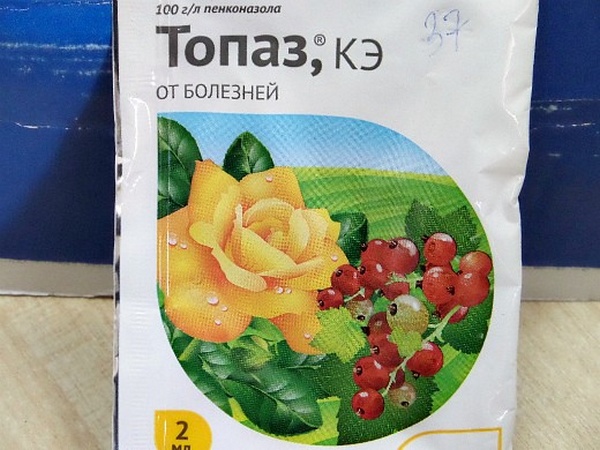
Topaz is considered the most effective fungicidal agent
Folk remedies
To treat rose bushes from fungal diseases, you can use not only chemical preparations, but also folk methods. The most effective folk remedies to cope with powdery mildew:
- When roses are covered with a white bloom, how to process them? First of all, you should use a solution that contains iodine and milk serum. To prepare it, you will need to add 8-10 drops of iodine and 1000 ml of milk whey to 5 liters of water. Processing is carried out every 7 days for a month. Milk serum makes it possible to heal the damaged area.
- Ash processing. To prepare the infusion, you need to dilute 1000 g of wood ash in 12 liters of water. The product is mixed and infused for 3 days. After a specified period of time, the infusion must be filtered and used to spray the bushes. If the liquid runs off the foliage, you can add a small amount of laundry soap to the infusion. The sediment that remains in the bucket should be poured under the plant.
- Baking soda is an effective spray on ornamental leaves. 200 g of the product is combined with 5 liters of water. Spraying is carried out in 3 stages. A break of 7-10 days should be taken between each stage.
- Cow manure will need to be diluted with water (proportion 1: 3). Having insisted the remedy for 2-3 days in the open air, it should be diluted in 20 liters of water. After that, you can process the bushes.
- Soda ash (50 g) is diluted in 10 liters of water. 50 g of crushed laundry soap is added to the solution. With a slightly warmed solution, it will be necessary to process the rose every 5-7 days for a month.
- Potassium permanganate is an effective folk way to combat powdery mildew. 4 g of powder will need to be diluted in 11 liters of water. Spraying is carried out several times at intervals of 3 days.

"Raek" is considered an analogue of "Spore"
Downy mildew
The disease is caused by a parasitic type of fungus, which can manifest itself in the cold season on the remaining foliage of the crop. Downy mildew is often caused by systematic waterlogging of the soil. The leaf plates of the affected plant are covered with a white bloom, which is concentrated from the bottom of the green mass. The appearance of plaque resembles mold. Gradually, the spots turn red or brown, after which the leaf plates begin to deform.
If the leaves of a rose turn white, what to do in this situation? It is extremely important to systematically examine the bushes in order to start treating the disease in a timely manner. Affected shoots are cut and burned. Bushes are treated with drugs of the type:
- Bordeaux liquid.
- Copper sulfate.
- Copper soap solution, etc.
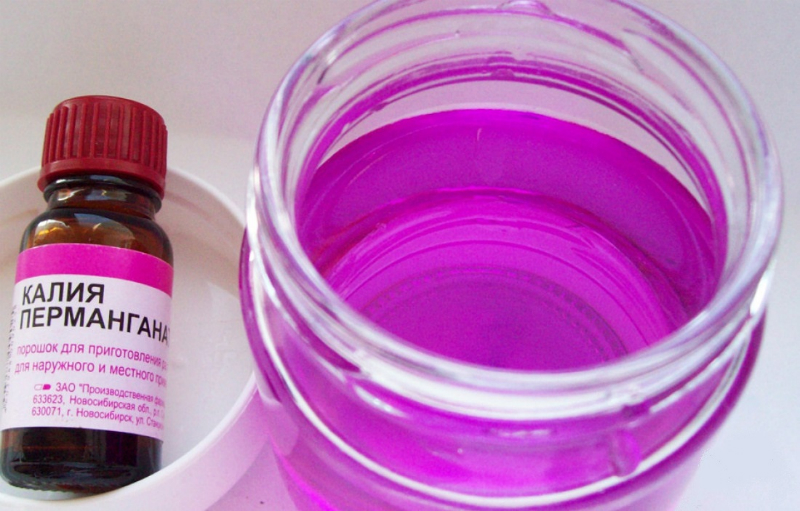
A solution of potassium permanganate will help to quickly cope with powdery mildew
Disease Resistant Rose Varieties
There are varieties of roses that are practically not susceptible to fungal diseases. Below you can find a description of the most popular varieties.
Leonardo da Vinci
The height of powerful bushes reaches 100 cm. The shoots grow strongly. Glossy leaf plates are painted in a dark emerald palette, goblet buds in pink tones. The diameter of the buds reaches 10-12 cm. A pleasant aroma emanates from the flowers. The street rose is not susceptible to fungal diseases, but it is not able to survive the dry period.
Wedding Bells
The diameter of the double flowers reaches 11 cm. The buds are painted in pink and silver shades. The height of the rose reaches 90 cm, and the diameter of the bushes does not exceed 60-65 cm. The main condition for growing the Wedding Bells variety is planting in an area well-lit by the sun's rays. The soil at the landing site must be fertile.
New Down
The diameter of pink flowers does not exceed 8-9 cm. The flowering period lasts throughout the summer. The variety is winter-hardy. Shiny leaf plates give the bushes a special appeal. The height of highly branched plants reaches 3 m. Shoots differ not only in length, but also in flexibility. A significant advantage of the New Dawn rose is its unpretentiousness.
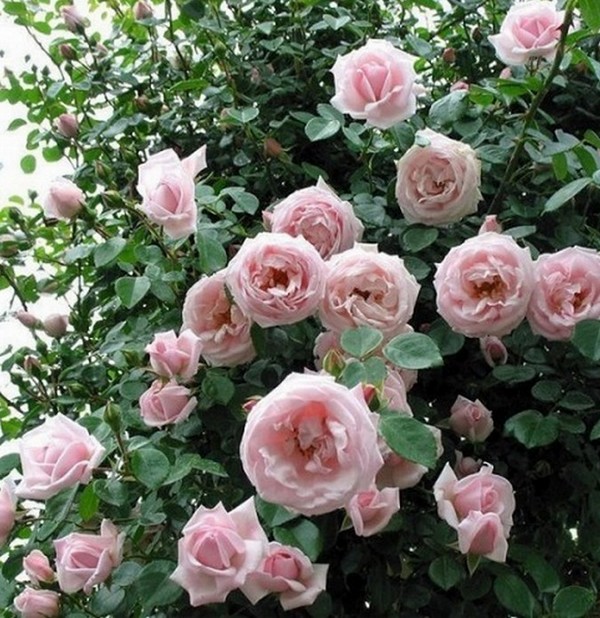
New Dawn is not susceptible to fungal diseases
William Shakespeare 2000
The tall bushes form velvety red flowers. The diameter of the opened buds exceeds 11 cm. Each flower contains about 70 petals. Flowering lasts up to 14 days.
Rosarium Uterson
The flowering of the rose is profuse and long lasting. The variety is planted exclusively on fertile soil. It is important to moisten the soil in a timely manner. Rosarium Uterson is not susceptible to fungal diseases.
Prevention of white plaque on rose bushes
To avoid diseases such as powdery mildew and gray rot, it is important to follow the farming practices listed below.
- Every October, you should cut off the affected shoots from the bushes and burn them. Thus, the fungus will not be able to overwinter and spread with the onset of heat.
- Regular weeding around the bushes makes it possible to avoid the growth of weeds, on which the fungal infection first appears.
- Watering the rose from sprinklers should be avoided, since this method of moistening the soil can create favorable conditions for the spread of fungal spores.
- Thickening of the plantings is unacceptable, which negatively affects the free circulation of air in the rose garden.
- You should not use fertilizers containing nitrogen in their composition at the end of summer.Such fertilizers have a positive effect on the growth of green mass, but at the same time make the bushes vulnerable to fungal diseases.
- To increase the rose's resistance to fungal infections, it is worth adding potassium-phosphorus fertilizers to the soil every spring, which accelerates the ripening of shoots and buds.
- At the end of November, experts recommend treating the soil at the place of planting roses with preparations containing copper.
- When purchasing rose seedlings, it is important to pay attention to the manufacturer's indication of how resistant the selected variety is to powdery mildew.
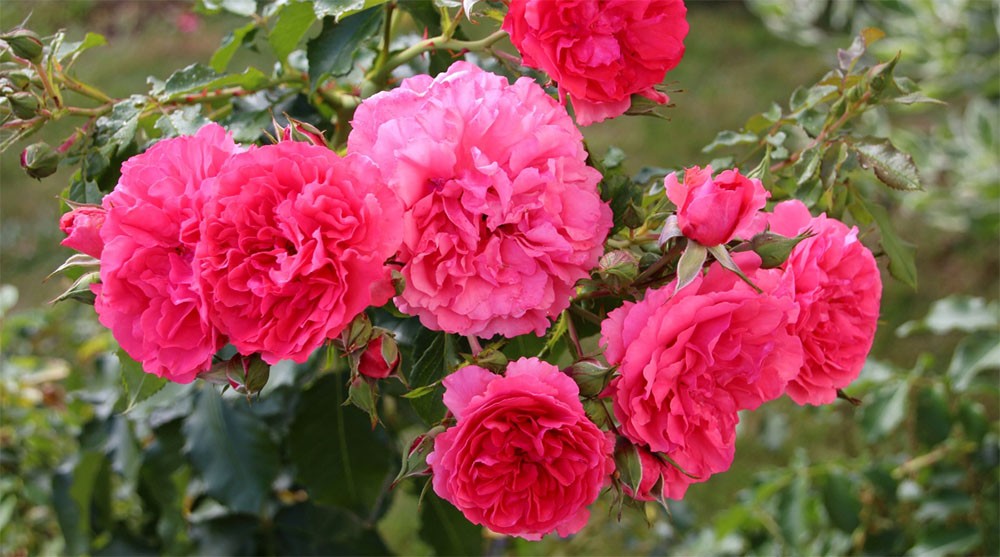
Rosarium Uterson is not susceptible to powdery mildew
Fungal infection is considered a serious threat to rose bushes. However, by timely recognizing the ailment and taking measures to treat it, you can save your favorite flowers. When carrying out treatment with chemicals, it is important to strictly follow the manufacturer's recommendations regarding dosage.
